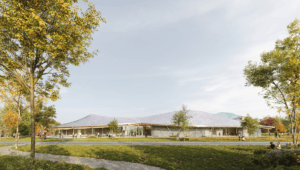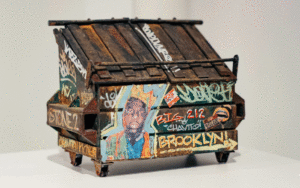Esteemed British artist Cornelia Parker has placed an ominous looking barn on the roof of The Metropolitan Museum of Art in New York. The installation, according to Parker, was inspired by Edward Hopper’s House by the Railroad painting.
Under its official title, The Roof Garden Commission: Cornelia Parker, Transitional Object (PsychoBarn) is the fourth rooftop installment the Met has overseen in what is becoming a yearly occurrence.
When speaking of the rooftop feature, Parker says that she was “daunted” by the skyline surrounding the site. As a result, Parker, who’s from Cheshire in the North of England, says that she wanted to place an “incongruous, domestic house” on top of the Met. Initially, Parker had planned for a much bigger traditional red barn, however, she quickly realized that these were “far too big.”
The result is a sinister looking barn, dubbed “PsychoBarn” due to its similarities with the infamous Bates mansion used in Alfred Hitchcock’s film Psycho. In fact, that is in part from where Parker drew her inspiration. When reading into Edward Hopper’s House by the Railroad she discovered that the painting inspired Alfred Hitchcock to use an eerily similar barn structure for Bates mansion in his epic, Psycho.
Likewise, Parker’s creation is equally ominous. Formed from a deconstructed red barn, a prominent image in American architecture and indeed Hopper’s work, the PyschoBarn rises 30 feet on the Met’s rooftop. While it hardly makes a dent in the New York Skyline, it’s a welcome variation on the typical imprint new builds have on the cityscape today.
A closer look reveals that the barn is incomplete. Instead, it is two facades merely held upright by scaffolding and supports, emulating how Bates’ mansion was constructed on set for Psycho. The successful deception of being a real barn is Parker’s way of blurring authenticity and illusion through the process of assumption.
“When you round the corner, you might think it’s the house from Psycho, or you might think it’s a red barn,” Parker said. “It’s cognitive dissonance. You oscillate in between two things—one is cozy, the other malign.” She added, “It’s not a one-liner.”
On their website, the Met says: “The piece flickers between the physical reality of the barn and the cinematic fiction of the house, bringing up their respective ties to comfort and discomfort. Neither entirely real nor completely false, it vacillates unnervingly between its identities.”
“The title of Parker’s work alludes to the psychoanalytic theory of transitional objects used by children to help negotiate their self-identity as separate from their parents.”
Sheena Wagstaff, the museum’s Leonard A. Lauder Chairman of modern and contemporary art, also said: “Cornelia has developed an astonishing architectural folly. It intertwines a Hitchcock-inspired iconic structure with the materiality of the rural vernacular.”
“Combining a deliciously subversive mix of inferences, ranging from innocent domesticity to horror, from the authenticity of landscape to the artifice of a film set, Cornelia’s installation expresses perfectly her ability to transform clichés to beguile both eye and mind.”










